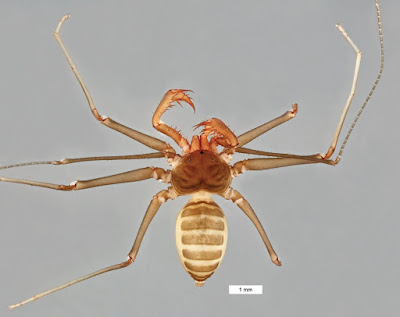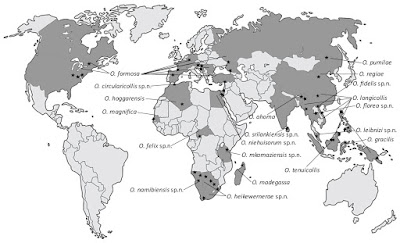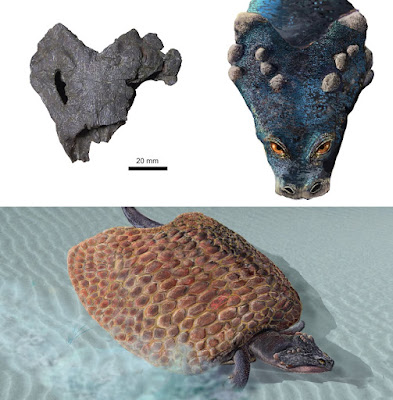[Most Recent Entries] [Calendar View]
Friday, May 25th, 2018
| Time | Event | ||||
| 3:12a | [Arachnida • 2018] Charinus kakum • A New Species of Charinus (Amblypygi: Charinidae) from Ghana, with Notes on West African Whip Spiders
Abstract The fauna of whip spiders (Amblypygi) in Western Africa is poorly known but probably diverse. Here, I describe the new species Charinus kakum sp. n. based on female morphology, and accompanied by DNA sequence data. The species is small and differs from other African species of Charinus in the low number of pseudosegments on leg IV, female genital features, spination patterns of the pedipalp, and small body size. It was collected from wet tropical rainforest in Kakum National Park, Ghana and is only the fourth species of Charinus to be recorded from the highly diverse Western African biodiversity hotspot. With a total body length of not even 6 mm it is also one of the smallest whip spiders in the world. Key Words: Amblypygid, Arachnida, Kakum National Park, new species, taxonomy
Charinidae Quintero, 1986 Charinus Simon, 1892 Type species: Phrynus australianus L. Koch, 1867, by original designation. Taxonomic remarks: Weygoldt (2000a) defined Charinus based on the armature of the pedipalp: with three large dorsal spines on the tibia of which the first one is the largest and the others decrease proximally in length; spine 1 sometimes followed distally by one to three spinelets, pedipalp basitarsus with two spines of which the distal spine is largest. Charinus also differs from the closely related Sarax in lacking ventral sac covers (Rahmadi and Kojima 2010). The genus currently includes more than 70 species (Vasconcelos and Ferreira 2017) but is in need of revision (Weygoldt 2000a, b). Nonetheless, the new species aligns well with the current genus diagnosis and is placed here until such revision has been carried out. Charinus kakum sp. n. Diagnosis: Charinus kakum sp. n. differs from the cave-inhabiting species C. milloti Fage, 1939 and C. fagei Weygoldt, 1972 in low number of tibial segments on leg IV (5 in C. millotei and C. fagei vs. 3 in C. kakum), trichobothria patterns of leg IV (compare with Weygoldt 1972, 2000a), small body size (prosoma length 2.6 in C. kakum), and shorter legs; from the island species C. africanus Hansen 1921 through the female genital operculum which has a steep ventral flexure at about two third of its length in C. africanus (Weygoldt 1972; Miranda et al. 2016b) but is uniform in C. kakum, and body size (ca. 8.0–8.5 mm in C. africanus and 5.8 in C. kakum; Hansen 1921). .... Etymology: The specific epithet refers to the type locality, Kakum National Park in Ghana. Distribution: Only known from the type locality by a single female individual. The wider distribution remains unknown and unfortunately no other specimens could be collected, despite targeted searches in the vicinity of the type locality. Danilo Harms. 2018. A New Species of Charinus (Amblypygi: Charinidae) from Ghana, with Notes on West African Whip Spiders. Evolutionary Systematics. 2: 45-53. DOI: 10.3897/evolsyst.2.24505 | ||||
| 9:18a | [Entomology • 2018] Taxonomic Revision of the Genus Oodera Westwood, 1874 (Hymenoptera, Chalcidoidea, Pteromalidae, Cleonyminae), with Description of Ten New Species Abstract The world species of Oodera Westwood, 1874 (Chalcidoidea: Pteromalidae: Cleonyminae: Ooderini) are revised. We examined 115 specimens of this rarely collected genus and based on morphological characters assign 110 specimens to 20 recognised species, of which the following ten are described as new: Oodera circularicollis sp. n. (Morocco), O. felix sp. n. (Central African Republic), O. fidelis sp. n. (Vietnam), O. florea sp. n. (Thailand), O. heikewernerae sp. n. (Botswana and South Africa), O. leibnizi sp. n. (Papua New Guinea, Malaysia and Phillippines), O. mkomaziensis sp. n. (Tanzania), O. namibiensis sp. n. (Namibia), O. niehuisorum sp. n. (Egypt and Israel), and O. srilankiensis sp. n. (Sri Lanka). Oodera monstrum Nikol’skaya, 1952, syn. n., is synonymised under O. formosa (Giraud, 1863). Five specimens could not be assigned to species and are treated as Oodera sp. Redescriptions are provided for all previously described valid species. Oodera albopilosa Crosby, 1909 is excluded from Oodera and transferred to Eupelmus Dalman, 1820 (Eupelmidae) as E. albopilosa (Crosby, 1909) n. comb. Oodera rufimana Westwood, 1874 and O. obscura Westwood, 1874 are treated as nomina dubia because we were unable to locate type specimens and the original descriptions are not sufficiently informative to clarify the taxonomic status of these names. Several specimens from North America are identified as introduced specimens of the European species O. formosa. We provide images and diagnostic characters for all 20 included species and an identification key to species. Keywords: Taxonomy, parasitoid wasps, identification key, new species Jennifer Werner and Ralph S. Peters. 2018. Taxonomic Revision of the Genus Oodera Westwood, 1874 (Hymenoptera, Chalcidoidea, Pteromalidae, Cleonyminae), with Description of Ten New Species. Journal of Hymenoptera Research. 63: 73-123. DOI: 10.3897/jhr.63.12754 | ||||
| 2:44p | [Paleontology • 2018] Parahenodus atancensis • A New Placodont from the Upper Triassic of Spain provides New Insights on the Acquisition of the Specialized Skull of Henodontidae
Abstract Henodus chelyops Huene is considered to be a highly autapomorphic cyamodontoid placodont with specialized trophic adaptations relative to all the other members of Placodontia. It has been exclusively found in the Carnian (Upper Triassic) of Tübingen (Germany). Here we present a partial skull identified as a new cyamodontoid placodont from the Upper Triassic of El Atance (Guadalajara Province, Spain), Parahenodus atancensis gen. et sp. nov. It is recognized as the sister taxon of H. chelyops, both taxa composing the clade Henodontidae. An emended diagnosis for H. chelyops and Henodontidae is given here. Parahenodus atancensis shares with H. chelyops several cranial characters considered until now to be autapomorphic for the latter, but it also retains some states common in most cyamodontoids. Thus, the discovery of P. atancensis provides new information on the acquisition process of the highly specialized skull of the Henodontidae. Key words: Placodontia, Cyamodontoidea, Henodontidae, Parahenodus atancensis, El Atance. SYSTEMATIC PALAEONTOLOGY SAUROPTERYGIA Owen, 1860 PLACODONTIFORMES Neenan et al., 2013 PLACODONTIA Cope, 1871 CYAMODONTOIDEA Nopcsa, 1923 CYAMODONTIDA Nopcsa, 1923 HENODONTIDAE Huene, 1936 Type species. Henodus chelyops Huene, 1936. Included species. Henodus chelyops, Parahenodus atancensis gen. et sp. nov. Emended diagnosis. Clade of Cyamodontida characterized by the following exclusive characters: flat skull; maxillae without tooth plates but with a deep ventral longitudinal groove; palatines with a single posterior tooth plate; upper temporal fenestrae reduced to absent; parietals broad and fan-shaped; presence of contact between the jugals and the squamosals; palatines separated from one another by long pterygoids; cephalic condyle of the quadrates posteriorly expanded and abutting a ventral flange of the squamosals. Distribution. Upper Triassic (Carnian to Norian) of Europe (southern Germany and central Spain). Genus HENODUS Huene, 1936 Type species. Henodus chelyops Huene, 1936. .... Genus PARAHENODUS nov. Type species. Parahenodus atancensis sp. nov. Parahenodus atancensis sp. nov. Derivation of name. Para (paqa), Greek for ‘near’ or ‘beside’, implying morphological closeness to Henodus Huene, 1936; atance, from El Atance, the fossil site; and ensis, a Latin adjectival suffix meaning ‘pertaining to’. Carlos de Miguel Chaves, Francisco Ortega and Adán Pérez‐García. 2018. A New Placodont from the Upper Triassic of Spain provides New Insights on the Acquisition of the Specialized Skull of Henodontidae. Papers in Palaeontology. DOI: 10.1002/spp2.1218 Describen una nueva especie de placodonto que habitó en Guadalajara durante el Triásico Superior divulgauned.es/placodonto/ via @divulgauned |
| << Previous Day |
2018/05/25 [Calendar] |
Next Day >> |

















